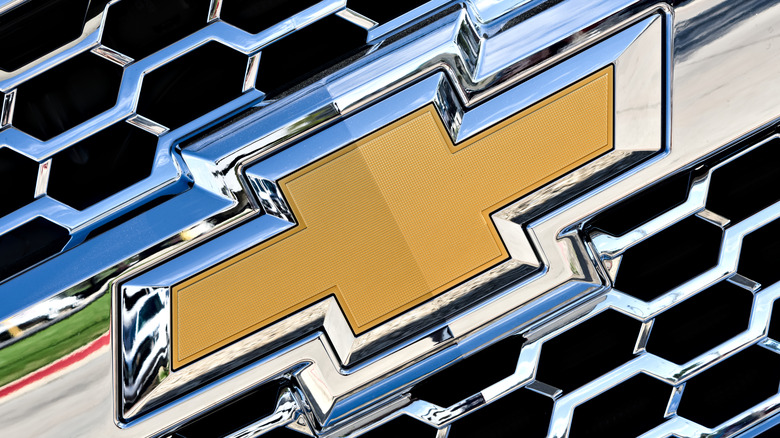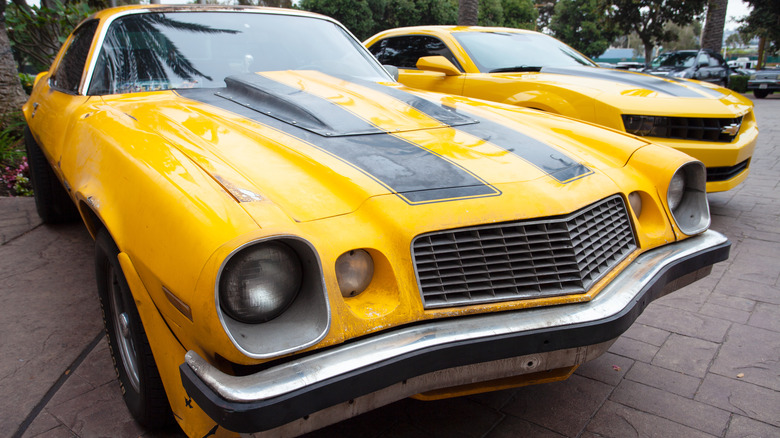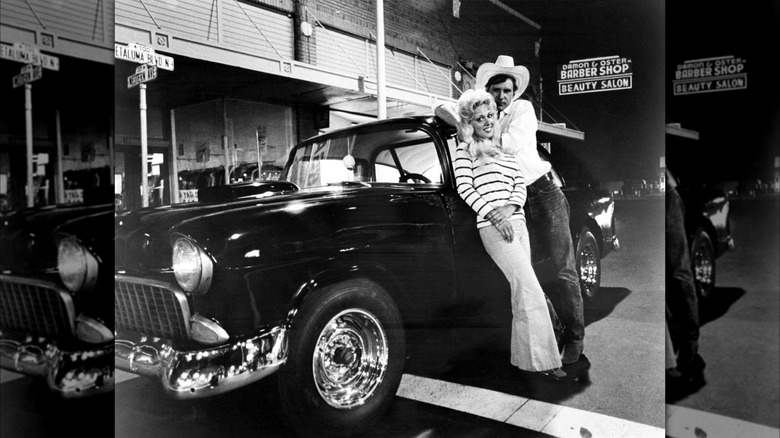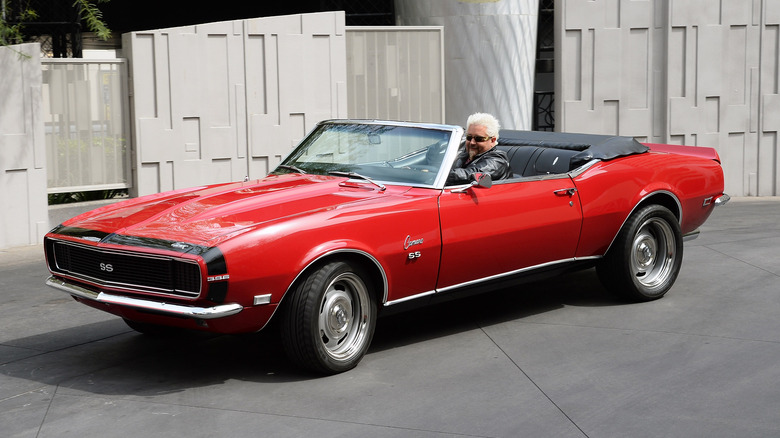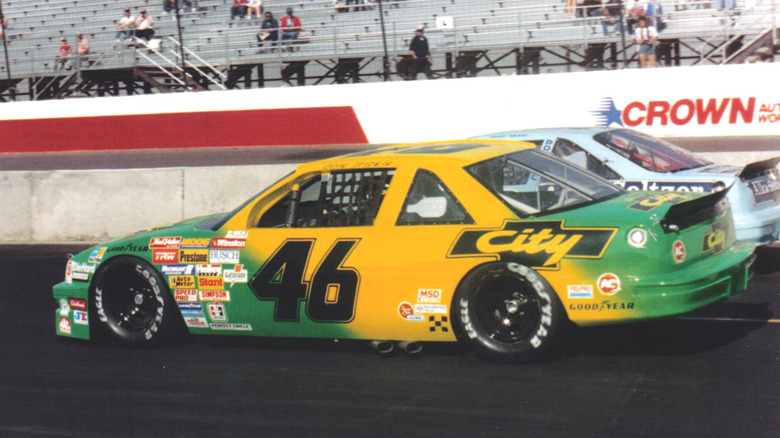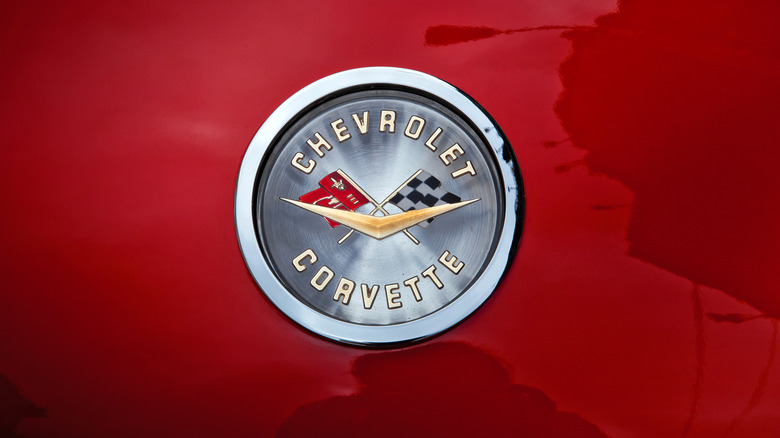6 Of The Most Famous Chevys In Pop Culture
If you were of TV-watching age during the 1970s, then you know that Chevrolet is as American as baseball, hotdogs, and apple pie. That ad ran constantly, and all these decades later it still resonates on a subconscious level deep in the minds of a whole lot of people.
It shouldn't come as a shock that General Motors (really, all carmakers) did their best to slip Chevys into pop culture wherever it could because it's a great marketing strategy. Getting the cars in front of as many eyeballs as possible does wonders for brand recognition and, in many cases, makes people sit up in their seats. If they didn't buy the vehicle outright, they might at least go for a test drive, which is a step closer to keeping the brand at the forefront of a person's mind.
The All-American car brand has indeed left an indelible imprint on pop culture. From television shows to songs, movies, and even NASA astronauts who flew to the moon (and hot-rodded around in Corvettes while on Earth), dozens of Chevys of all makes and models have had their 15 minutes of fame at one time or another. And while our list is totally subjective, it'll give you an idea of just how transcendent the brand has become.
Multiple Camaros appeared in the Transformers series
For Michael Bay's "Transformers" to become a film franchise, it had to start with a bang. In 2007, Shia LaBeouf, Megan Fox, and Josh Duhamel led a special effects-laden spectacle to a worldwide gross of over $700 million. LaBeouf's character, Sam Witwicky, is guarded by the Autobot known as Bumblebee, who is initially disguised as a "semi-classic" 1977 Chevrolet Camaro Z/28 (aka "Beater Bee") with a "custom faded" yellow paint job and black rally stripes, a hood scoop, Hurst shifter, and mismatched chrome hot rod wheels.
After getting called a "piece-of-crap" by Mikaela Banes (Fox), he promptly transforms into a brand new, fully loaded 2006 Camaro concept sporting a retro-inspired look from the late 1960s, much to the delight of Sam and Mikaela. A 400-horsepower 6.0-liter LS2 engine with an aluminum block and heads powered that real-life fifth-generation concept. Mated to a 6-speed manual transmission, it had four-wheel independent suspension and Active Fuel Management, capable of closing off four cylinders when under a light load to achieve 30 mpg.
Another version appeared in 2011's "Transformers: Dark of the Moon" and two more in 2014's "Transformers: Age of Extinction." The story behind how and why Camaros were featured throughout the franchise is interesting, and their inclusion drove the Camaro's popularity to new heights. Chevy even released a Transformers Edition with black rally stripes and Autobot badging. Four of the film-used Bumblebees sold at auction in 2019 for $500,000, with Chevy donating the money to an organization that helps military families.
The 1955 Chevy 150 was iconic in American Graffiti
Before George Lucas shocked the world with "Star Wars," he made the 1973 film "American Graffiti." Not only did it earn over $140 million at the box office, but was nominated for five Oscars, including Best Picture and Best Director. The film showcased many of Hollywood's upcoming stars, such as Richard Dreyfuss, Ron Howard, Suzanne Somers, Cindy Williams, Harrison Ford, and yes... the cars.
One might jump straight to the yellow deuce coupe (a 1932 Ford Standard), which in the film was "the fastest thing in the valley." We want to highlight the black 1955 Chevy driven by Harrison Ford's character, Bob Falfa, which had a big hood scoop and roll cage. Over the years, it has been mistaken for a Chevrolet 210 and Bel Air, but it's actually a 1955 150 sedan.
It's easy to confuse them because all three are basically the same car with different trim packages. The 150 had no side trim, while the 210 only had trim behind the front door. The trim on the top-of-the-line Bel Air stretched from the front fender all the way back to the quarter panel.
When the 150s were new, they came with a renovated chassis and Chevy's new small-block V8, producing between 123 and 162 horsepower. Customers could also choose from three different transmissions. Interestingly, Falfa's 150 was one of three initially built for the 1971 film "Two-Lane Blacktop," while a second was used in the crash scene at the end of the film.
Guy Fieri cruises America in a 1968 Camaro SS convertible
Love or hate him, Guy Fieri is a pop culture icon who refuses to be confined to the culinary world. The bombastic Food Network star is famous for his spiky beach blonde hair, and despite the many shows he's part of, Triple D ("Diners, Drive-Ins, and Dives") is the one you likely know him from. One could say the "co-star" of Triple D is the 1968 Chevrolet Camaro SS convertible Guy drives at the beginning and end of every episode, which began in 2007 and is now in its 48th season (that's over 400 episodes).
According to Fieri, the SS used on the show is a complete frame-off restored '68. The original 396 horsepower engine was replaced by a GM Performance ZZ 502 crate engine, producing 502 horsepower and 567 lb-ft of torque. It was mated to a Tremec 5-speed manual and had a Hotchkiss suspension system to ease the ride. It's one of the cars Fieri owns, proving he does indeed have great taste.
Another Camaro SS, this one a '67 Super Sport coupe, appeared in the 1985 film "Better Off Dead" starring John Cusack. The producers added a rear spoiler, swapped out the stock 350 V8, and dropped in a 400 HP engine. This particular SS is one of many classic muscle cars that made it to the movies, and although it wasn't a "star" per se, it certainly played a pivotal role in the storyline of the popular 80s film.
A 1990 Lumina tore up the track in Days of Thunder
In 1990, Tom Cruise was in a movie that did as much for NASCAR as "Top Gun" had done for Navy recruitment. "Days of Thunder" had a star-studded cast, led by Cruise as hot-headed driver Cole Trickle, whose vehicle of choice was a 1990 Chevrolet Lumina. The film would go on to have a worldwide gross of $157,920,733 and bring new fans to stock car racing while bolstering sales of the car itself.
The film's timing was impeccable because Chevy had "retired" the Monte Carlo as its de facto stock car and introduced the Lumina at Talladega in May 1989, so for Cruise to be driving one in a high-profile, big-budget Hollywood movie about NASCAR was about as good as anyone could have hoped for.
The track version of the Lumina was strapped with a thunderous V8 and rear-wheel drive. The one made for public consumption, however, had front-wheel drive and was saddled with much smaller engines, including a 3.4-liter twin dual-cam V6, a 3.1-liter LHO V6, and two straight-four versions (2.5 and 2.2 liter).
The Lumina was only used for a handful of years before a new Monte Carlo rolled up to the starting line in 1995, but during its time, it had 169 starts and 61 victories, with the first coming just three weeks after it debuted at Talladega. Of those, Dale Earnhardt had the most with 28, and four of his seven premier series championships were won driving a Lumina.
[Featured image by us44mt via Wikimedia Commons | Cropped and scaled | CC BY-SA 2.0]
Ryan Gosling rocked a 1973 Chevrolet Chevelle Malibu in Drive
Ryan Gosling is one of Hollywood's premiere A-list actors. His films ("Barbie," "La La Land," "The Notebook") have earned a worldwide gross of over $2.7 billion. In 2011, he starred in "Drive," where he portrayed a Hollywood stuntman moonlighting as a getaway driver for criminals.
In the decade-plus since its release, it has become a well-regarded film — almost a cult classic, really — thanks to its gritty realism and performances from several high-profile actors (Ron Perlman, Bryan Cranston, Oscar Isaac). Gosling's character personally drives a stripped-down primer gray 1973 Chevrolet Chevelle Malibu in the film.
This fourth-generation Chevelle packed a 350 cubic inch V8 engine (despite the 454 badges up front), an automatic transmission, after-market gauges, steering wheel, safety harness, and mag wheels. Interestingly, Gosling went the extra mile for this car, making the story behind this particular '73 Chevy Malibu worth reading. Let's just say it involves a whole lot of personal involvement. Apparently, Gosling even did some of his own stunts in the film.
For a runner-up Chevelle Malibu, see Quentin Tarantino's 1994 film "Pulp Fiction." The film had such an impact on pop culture that it's hard to quantify. Sure, Vincent Vega's (John Travolta) 1964 Chevy Chevelle Malibu convertible shows up only briefly in the film, but it takes him and Mia to Jack Rabbit Slim's, where that memorable dance takes place. Oh, and what happened to the real-life Malibu from "Pulp Fiction" is as wild as the film.
The Chevy Corvette is famous all over
The Corvette is perhaps the most pop culturally significant vehicle Chevy has ever made (rivaled only by the Camaro), so we're not focusing on one specific model or year, but the 'Vette as a whole. When the first 300 hand-built models rolled off the line in Flint, Michigan, in June 1953, no one had a clue that the Corvette would go on to become such a ubiquitous part of the American landscape.
In 1960, the C1 routinely appeared in the television show "Route 66" (1960 – 1964) and the Bob Hope/Lucille Ball-led film "Facts of Life." When Alan Shepard became the first American in space in May 1961, GM's president gave him a new Corvette. A Chevy dealer later leased Corvettes to all the Mercury astronauts for $1 a year, and this connection to NASA's superheroes cemented the 'Vette as the All-American joyride. In 1963, The Beach Boys released their ode to the Corvette Stingray in a song called "Shut Down."
Mattel's Barbie got her first dream Corvette (with G70-14 Super Slicks) in 1976. A wildly customized Stingray appeared in Mark Hamill's 1978 film, "Corvette Summer," while another was the focal point of a cops and robbers chase in the aptly titled "Stingray" (1978). Then there's the 1959 C1 owned by Eric "Otter" Stratton in the raucous '78 cult classic, "Animal House."
A C4 coupe gets a serious beatdown in "The Big Lebowski" (1985), dropped from a plane in the Nicolas Cage action film "Con Air" (1997), and in 1998, WWE legend Stone Cold Steve Austin cemented Vince McMahon's new C4. To this day, the Corvette still shines brightly.
